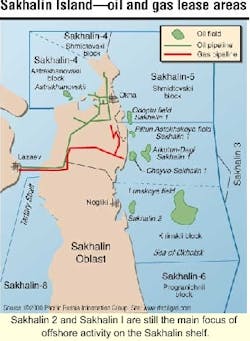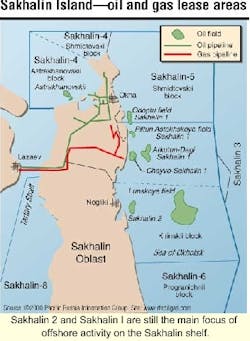ASIA/PACIFIC: Sakhalin consortia edging towards gas pipeline, LNG projects
Shell and Exxon-Mobil are planning to move forward with field development of gas reserves offshore Sakhalin Island, but appear to disagree over the optimum export method. Also, Sakhalin's authorities want to step up offshore activity, but remain thwarted by the Russian legislative process.
These were among the key points to emerge from the Sakhalin Oil & Gas Conference in London, organized by IBC Global Conferences. Despite the frustrations, much of the forecasting of project schedules was more definite than in previous events, suggesting that Russian President Putin's interventionist approach is starting to take effect.
As usual, the consortium with the most to report was Sakhalin II, which began producing oil via the Molikpaq platform in 1999 from the Piltun-Astokhskoye Field. Alan Grant, President of Sakhalin Energy Investment Company, said that 11 million bbl of oil had been extracted by mid-November, with daily rates averaging 70,000 bbl. "The Vitaz crude is high quality, 34 degree API, and so gets a premium on the market." Main customers for the oil are Korea and China, with small amounts going to China. The partners recently leased a brand new, double-hulled tanker to aid flexibility to the loading schedule, which is frequently hampered by severe weather. However, despite winter hailstones assaulting the Molikpaq horizontally in machine-gun mode, there had been no lost-time incidents impacting production right through to November.
By mid-2001, the partners hope to submit a second-phase development plan also taking in the untapped Lunskoye gas/condensate field, where recent appraisal drilling lifted gas estimates from 13.6 tcf to 18.9 tcf. This will entail a second platform on Piltun-Astokhoskoye, a $250-million water injection package for the Molikpaq, and another platform dedicated to Lunskoye, producing up to 17 bcm per year by the middle of the decade.
Management shifts
Following Marathon's decision to sell its stake in the PSA to Shell, the latter is now overwhelmingly in charge - the other partners are Mitsui and Mitsubishi. In December, a new management team was put in place, based at Shell's offices in Rijswijk, The Netherlands, and headed by Steve McVeigh, ex-Shell Oil in Houston. Sakhalin Energy's old Houston office was recently closed, but the Moscow operation has been retained. Shell's dominance should add impetus to the project, given its stated desire to realign itself as a global force in gas and LNG.
Assuming the platform plans are approved by the authorities, a treatment facility would also be built on Sakhalin to handle gas and crude from the two fields. Concurrently, gas and oil pipelines would be laid to the south of the island, with capacity in the gasline of 18 bcm/yr.
This would meet demand for a planned two-train, 9.2 metric ton/yr liquified natural gas (LNG) plant, and also supplies to the domestic Russian market. That capacity could be raised later on through additional compressor stations. An LNG project specification contract has already been awarded to a consortium of Fluor Daniel, Chiyoda, and Nipigaspererabotka.
Far Eastern gas buyers are always looking to diversify sources, and an LNG scheme based in Sakhalin could have an edge, Grant maintained. For instance, the distance by carrier to Chinese terminals would be 2,100 nautical miles, compared with over 5,000 miles from Qatar and Australia. "Also," Grant pointed out, "in the tropics, production is flat year round, but on Sakhalin, there would be much more efficiency in terms of productivity during winter, which is advantageous to the markets."
Speed up approvals
For all this to happen by mid-decade, however, will require a transformation in the approvals process. For Phase 1, the partners had to work with multiple approval bodies at federal, regional, and district levels, Grant said, leading to a massive duplication of effort. This led to over 600 approvals being required. With the scope of the Phase 2 scheme, that tally could rise beyond 3,000, he complained. "These are outdated, costly procedures that don't apply elsewhere."
To speed matters, Grant suggested that the government and legislative bodies establish a procedure for constructing field facilities under a development plan before project sanction is granted. The investor or operator would then be obligated to build those facilities to the approved standards during the design and construction phase. Once completed, agencies could then be brought in for facilities inspection.
"This would cut out repetitive reassessment," Grant claimed. "There would still be scope for environmental impact assessments after commissioning, working to international standards. However, Shell believes there should be just the one agency dealing with EIAs."
Neil Duffin, President of Exxon Neftegas, was less forthcoming about progress on Sakhalin I, although the consortium comprising Exxon, as operator, Rosneftegas, Sakhalinmorneftegas, and Sodeco is inching towards a development.
Confirmation well
Late in September, ExxonMobil announced that the seventh and final appraisal well had been completed on the Chayvo Field, confirming the presence of a 340 ft oil column on the field's west flank. This flowed at a test rate of 6,000 b/d. "Interpretation of the results will take some months," Duffin said, "but the size appears to be in line with our analysis." Gas reserves at Chayvo and the Arkutun-Dagi fields are now estimated at over 14 tcf, he added.
The partners believe that taking into account the results of their studies and 30 wells drilled previously, they have enough definition to proceed towards gas market discussions. In particular, they are targeting China, Japan, and Russia. "We feel a pipeline system is more economic than LNG for our gas," Duffin said, "but first Japan needs to establish a regulatory framework for pipelines."
Currently, the partners are thinking in terms of multiple, ice-resistant platforms for the first development phase, producing over 200,000 b/d of oil and 1 bcf/d of gas combined. "But we need assurances from the government to move it forward," he said. In 1999, the program suffered setbacks when the Chayvo appraisal well was vetoed on environmental grounds.
Duffin said that the partners had spent $500 million all told since signing their PSA in 1996, but some causes of the cumulative delays were contrary to the PSA agreement. "We need a streamlined approvals process that is rational ellipse and well understood by all the partners. And we also need to create best practice design codes for these unique conditions."
As for future PSAs offshore Sakhalin Island, the long-delayed signing of Sakhalin II (Kirinsky block) is still being negotiated by the Russian government's PSA Commission, said G.Pavlova of Sakhalin Oblast. Subsequently, it has to be approved by the State Duma, she added, but the approval mechanism has yet to be clarified.
Sakhalin IV appears to be in limbo following Arco's withdrawal early last year. Rosneft and SMNG are the remaining partners, but both are believed to be having some financial difficulties. Sakhalin V, which was to have been tendered as a single block, may now be dis- mantled into four separate blocks, although the Ministry of Natural Resources is opposing such a move, according to Valery Garipov, Russia's Deputy Minister of Fuel and Energy. Sakhalin VI is shaping up as a largely Russian concern, involving Petrosakh and possibly Rosneft and SMNG. Results of a seismic survey over this block point to significant gas structures, Garipov claimed.
Power Bridge
Any gas discovered here or in the other blocks could eventually feed the planned "Power Bridge" project to Japan. According to a paper given by Yury Kucherov, Head of Strategy and R&D Policy at RAO EES Rossii, a feasibility study has been undertaken in association with Marubeni, for the construction of a 4 MW power plant on Sakhalin Island fueled by 5-6 bcm/year of gas from around the Sakhalin Shelf.
From Sakhalin, the electricity would pass through four submarine, high voltage DC transmission lines connecting to converter stations in Honshu and Hokkaido islands. The length of the crossing from Sakhalin to Honshu would be 1,400 km, with a maximum seabed depth of 1,000 meters. Polypropylene laminated paper is at present the favored cable insulation medium.

